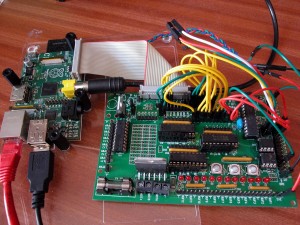The Gertboard is an add-on GPIO expansion and experimenter board for the Raspberry Pi computer. It comes with a large variety of components, including buttons, LEDs, A/D and D/A converters, a motor controller, and an ATmel ATmegs 328p AVR microcontroller which you can program using the standard Arduino IDE (with some minor modifications)
The Gertboard was designed by Gert van Loo, hence the name!
Operation of the Gertboard is relatively straightforward. A ribbon cable connects the Raspberry Pi to the Gertboard. This is then broken out with a row of pins, so every GPIO signal is avalable for your use.
Some of these pins can be directly jumpered via standard 2-pin jumper links to on-board functions – e.g. with a pair of 2-pin jumpers, the serial Rx and Tx can be connected directly to the ATmega’s Tx and Rx respectively, and with a few more 2-pin jumpers, the SPI pins can be jumpered to the Gertboard SPI peripherals. The other pins are available for your own use, or to connect to other devices on the Gertboard itself.
Gertboard Features:
- Full access to all the Raspberry Pi’s GPIO pins.
- Full access to all the pins on the ATmega.
- 12 digital buffers. Configurable for input or output via on-board 2-pin jumper links.
- 12 LEDs connected to the buffers to monitor the outputs.
- 3 Buttons to give input signals.
- SPI 2 channel D/A converter and a SPI 2-channel A/D converter.
- A motor controller capable of speed and direction control of a DC motor. (4 amp capacity)
- 6 Open-collector outputs to drive high power lamps, relays, etc.
One important (and good!) point to note is that all these functions can be accessed from either the Raspberry Pi or the ATmega microcontroller, so you can use the Pi to command the ATmega if you need additional PWM outputs for example (The Pi only has one PWM output), or to use the analog inputs on the ATmega, and so on.
These pages document my initial experiments with it, including how to get the AVR microcontroller going with the standard Arduino IDE.

